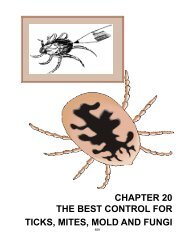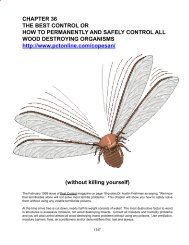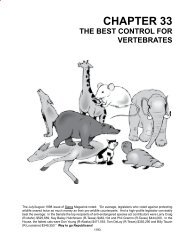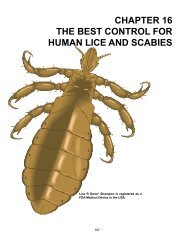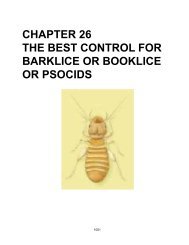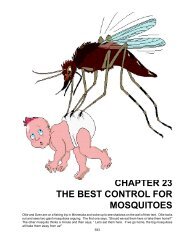decemlineata (Coleoptera: Chrysomelidae) and the diamondback moth, Plutella xylostella (Lepidoptera:Plutellidae), are strong runners-up. Resistance to synthetic pesticide POISONS will continue to increase inpest species, but not in people who are exposed to these dangerous toxins. At some point, resistance makesfarming uneconomical. Eventually, in order to survive, man will have to think rather than apply ever-increasingamounts of pesticide POISONS and use the safe and far more effective controls in this free IPM manual and/or find other alternatives. See also Immunity. A Friend of the Author in an Israel kibbutz said when he beganfarming he had to spray maybe once after planting before harvest; now he has to spray over 40 times! In January2010 the Grand Rapids Press noted Norway had controlled MRSA (see Chapter 41) by simply not routinelyprescribing antibiotics.Resistant Species - Often increase the quality of the crop. <strong>The</strong>se species can even decrease insect populationsin adjacent fields or yards. When insect pests feed on resistant species of plants they are often less vigorousand are more easily killed by natural controls, e.g., beneficials and adverse weather and/or other environmentalstresses.Resistant Varieties - You can simply avoid many plant diseases and pest species by growing only resistantplant species.Resolve to Persist until You Succeed - Never, never, never give up; unleash your stamina and mind andcreatifvity. Continue on!Results never lie.Review - Never stop reviewing your IPM strategies, especially your failures to see how you can better and moresafely control various pest problems.Rhubarb - Soak 3 pounds of rhubarb leaves in 1 gallon of water (in the dark) for at least 24 hours. Bring thewater to a boil, let simmer for 30 minutes - add 1 oz. of liquid soap and/or soap flakes - cool and spray therhubarb mix - it’s fun to see how many different pests, e.g., aphids, Japanese beetles, June bugs and fungaldiseases, this natural spray will control. Be careful; oxalic acid is harmful to you, too! If ingested, yourheart will stop and you will die!Right Stuff ® - Clean per the label with this stuff and insect pests die quickly.Rinse-and-Vacs and or Vacuums - <strong>The</strong> quickest and most effective way to remove pests, debris and food isto vacuum or rinse-and-vac. Do not forget to put Safe Solutions Tweetmint Enzyme Cleaners in the water and/or dust (corn starch or talcum powder) in the dry vac to kill the captured insects.Risk - Always consider the risk to non-target species; everything you do creates some degree of risk.Road Dust - will kill insect pests, e.g., striped cucumber beetles and cabbage worms.Robber Flies - Maggots live in soil or decaying wood and feed on beetle larvae. <strong>The</strong> adults come in variousbody styles and are voracious predators that catch flies, beetles, bees and grasshoppers by dropping down onthem from above. <strong>The</strong>y usually have bearded faces and are very strong.Rodent Baits - See baits containing artificial sweetners/pain killers.Rodent Traps - <strong>The</strong>y can be used to control rodents without resorting to the use of dangerous poisons, but still,be careful.Roofing Paper - Sticky bands of roofing paper wrapped around trees will prevent the ascent of ants, worms,caterpillars and other pests or will allow you to remove or turn the paper and control any pests hiding under theroofing paper.Rooibus - (pronounced “Roy-Bose”), a plant native to South African plant, has started to gain popularity throughoutthe world for its significant health benefits. From 1999-2001, consumption increased by 500%. Rooibos contains450
a wide variety of antioxidants called aspalathin, chrysoeriol, orientin, isoorientin, vitexin, isovitexin, quercetin, isoquercetrinand rutin. It is thought that these components of Rooibos tea are responsible for its growing eputationas an “antiaging tea” as well as promoting cell health and helping maintain healthy blood sugar and inflammation .Research has found that Rooibos tea helps with irregular heartbeats, colic and diarrhea . Now a new study hasbuilt upon previous research showing that Rooibos may be effective for asthma and high blood pressure byhelping decrease muscle spasms in blood vessels and lung airways.Rosary Pea - called Black-eyed Susan, Weather Plant, Precatory Bean, Crab’s Eye Vine or Jequirity Bean; thescientific name is Abrus precatorius, and is found growing all over Florida on Sabal palms, shrubs, fences, andundisturbed areas. <strong>The</strong> seeds contain abrin, one of the most toxic principles known. Less than one masticatedseed can kill an adult human - Abrin is a thousand times more toxic than arsenic. Be very careful!Rosemary (Rosemarinus officinalis) - Evergreen aromatic shrubs from the Mediterranean. Grows 2’ - 6’ withpale blue ½” flowers and attractive foliage. Powdered Rosemary leaves are used as a flea and tick repellent.Simply dust the powder onto the pet or areas where the pet sleeps. Rosemary oil will control lice. An effectiveand safer repellent. Rosemary is one of nature’s most powerful anti-oxidants and is helpful with memory lossand cancer prevention. You can also bring a quart of water to a boil and add 4 teaspoons of rosemary; let soakfor 20 -30 minutes . Drain and cool the solution and then spray your pets with the herbal rinse. Keep the petinside until the spray has dried. Use as needed to repel ticks and fleas.Rotation - Developing a good crop rotational plan is the first and most important step in the transition to IntelligentPest Management ® , sustainable agriculture, low-input or organic farming. Certain crops, like tobacco, potatoesand corn, are heavy feeders and should not be grown too often on the same soil, yet the Author has watchedfarmers ignore this sage advice year after year after year. This literally mines the soil rather than husbandingit. Planting the same crop in the same place year after year invites losses due to soil-borne diseases and overwinteringpests. Follow a crop rotation of at least 3 years for the four major vegetable plant families—Solanum(tomato, potato, pepper, eggplant); Cucurbit (melons, squash, cucumbers); Cruciferous (broccoli, cauliflower,cabbage, Brussels sprouts); and Allium (onion, garlic, leeks).Rotenone - extracted from Derris spp., Lonchocarpus spp. and/or Terphrosia spp. can be used as an insecticide.derris roots contain rotenone and crushed roots will kill fish when rotenone is thrown into the water. Rotenonehas been used since the 18th century.Rove Beetles - Most rove beetles and their larvae prey on aphids, fly eggs and maggots, mites, nematodes,springtails, etc.Rubbing Alcohol - will instantly kill most insects on which you spray it, including stinging insects, but be verycareful of your eyes and keep out of the reach of children and pets. You can also mix 1 T. - 3 T. of rubbingalcohol in a quart of water to kill most weeds, but put in 5 T. - 6 T. to kill poison ivy.Rue - Plant Ruta graveolens as a garden border or scatter shredded leaves to deter Japanese beetles. <strong>The</strong>oils from the leaves can be extracted and used as a spray to control or repel many insects. Rue is a flea andinsect repellent. It has been used to treat rheumatism, epilepsy and skin disorders. Caution: <strong>The</strong> oils givesome people a rash similar to that of poison-ivy and are toxic in large amounts!Rust <strong>Control</strong> - Take ¼ cup of shredded paper and place a thin layer of this paper at the base of the plant, e.g.,roses, snapdragons, hollyhocks, etc. and light the paper with a match; the quick flame will last 5 - 10 seconds andthen can be extinguished if necessary. Check again in a few weeks and repeat the fire treatment only as needed.Ryania - Puts insects into a state of “flaccid paralysis”. Roots and stems can be used to make a botanicalinsecticide.Rye Flour - Sprinkling rye flour over and around plants wet with dew will cause the resulting dough to cling tothe bodies of moths and worms so that they will bake in the sun and die.Sabidilla - Seeds are toxic to houseflies. It has been used as an insecticide since the Sixteenth Century. <strong>The</strong>451
- Page 1:
CHAPTER 11SAFE AND FAR MOREEFFECTIV
- Page 4 and 5:
pesticide poisons do - to them the
- Page 6 and 7:
American Beautyberry (Callicarpa am
- Page 8 and 9:
packets in 4 days or less. Aspartam
- Page 10 and 11:
Baking Soda - Baking soda or sodium
- Page 13 and 14:
Bioderivatives - are substances whi
- Page 15 and 16:
Bird feeders - will attract more th
- Page 17 and 18:
an abrasive action on the insect wh
- Page 19 and 20:
pathogens - volatiles produced duri
- Page 21 and 22:
ground, grain and stored product ap
- Page 23 and 24:
epels many insects, including flies
- Page 25 and 26:
een used medically since at least t
- Page 27 and 28:
Collateral Damage - When you spray
- Page 29 and 30:
Cottonseed Meal - is a source of ni
- Page 31 and 32:
Desiccants - Hot air, dehumidifiers
- Page 33 and 34:
Dogs - have been trained to sniff o
- Page 35 and 36:
elderberry leaves to protect them f
- Page 37 and 38:
controls pests and acts as a deodor
- Page 39 and 40:
contamination that no one can hones
- Page 41 and 42:
Chlorphyll Graphite Parrafin wax Wa
- Page 43 and 44:
Film Capsule - The plastic capsule
- Page 45 and 46:
Repel roaches with bay leaves and e
- Page 47 and 48:
person in your house, but you’ll
- Page 49 and 50: slender sickle-shaped jaws. They ap
- Page 51 and 52: epellent that contains only natural
- Page 53 and 54: infusion of pignut leaves, rubbed o
- Page 55 and 56: Human Hair - cut in small pieces wi
- Page 57 and 58: Insect Diseases - In 1836, Agostino
- Page 59 and 60: Irrigation Management - Improper ir
- Page 61 and 62: lack cutworms.Laxatives - Chocolate
- Page 63 and 64: we die. Check out magnesium in Chap
- Page 65 and 66: Milk Thistle - is a proven detoxifi
- Page 67 and 68: Moon Flower (Datura ioxia) - Do not
- Page 69 and 70: Spotted knapweed begins producing c
- Page 71 and 72: Nothing - Doing nothing is a choice
- Page 73 and 74: fertilizers and sprays will normall
- Page 75 and 76: added to enzyme cleaners or when us
- Page 77 and 78: yellow to yellow crystalline solid
- Page 79 and 80: Aureolaria virginica (L.) Pennell.
- Page 81 and 82: Clematis vitalba L. (Honduras fish
- Page 83 and 84: Euphorbia bicolor Engelm. and Gray.
- Page 85 and 86: Justicia adhatoda L. (Adhatoda vasi
- Page 87 and 88: Momordica charantis L. (Balsam-pear
- Page 89 and 90: Piper nigrum L. (Black pepper).Stro
- Page 91 and 92: Sesamum indicum L. (S. orientale L.
- Page 93 and 94: Xanthorrhoea hastilis R. Br. (Black
- Page 95 and 96: Pomander - Repel moths and other in
- Page 97 and 98: y Safe Solutions at 1-888-443-8738
- Page 99: ight red and cover them with petrol
- Page 103 and 104: Sawdust - Sawdust can be treated wi
- Page 105 and 106: lit charcoal in the tunnels would a
- Page 107 and 108: Active IngredientGeneric Name Trade
- Page 109 and 110: Sour Milk - sprays will loosen scal
- Page 111 and 112: Stay Calm - Take a deep breath amd
- Page 113 and 114: to make the mix about the consisten
- Page 115 and 116: pesticides have never controlled or
- Page 117: Temperature - Increase or lower tem
- Page 120 and 121: in colder climates. The most fragra
- Page 122 and 123: and/or dehumidifiers, plumbing and
- Page 124 and 125: odents, scorpions, etc. to your bai
- Page 126 and 127: Oregano also contains four anti-ast
- Page 128 and 129: like colds, and headaches and spend
- Page 130 and 131: then estimated human population. Gi
- Page 132 and 133: “The choice, after all, is ours t
- Page 134: 484



